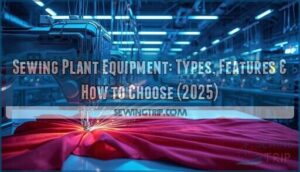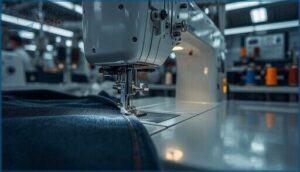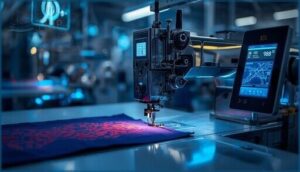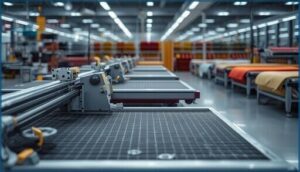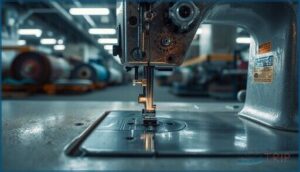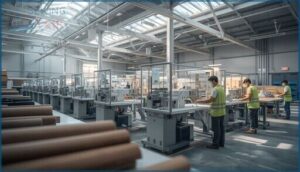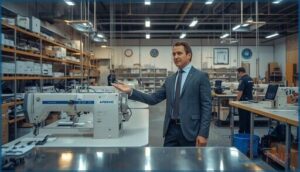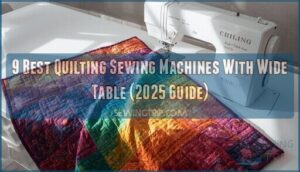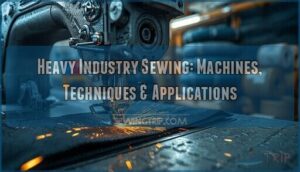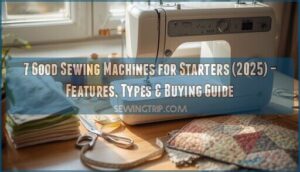This site is supported by our readers. We may earn a commission, at no cost to you, if you purchase through links.
Your production line grinds to a halt when a needle breaks, thread tension goes haywire, or a cutting blade dulls mid-shift. Every minute of downtime costs you money, and outdated sewing plant equipment multiplies those losses across dozens of operators and thousands of garments.
Modern industrial machinery has evolved beyond basic stitching—lockstitch machines now fire off 5,500 stitches per minute with servo motor precision, while automated systems integrate AI intelligence and predictive sensors that flag problems before they derail your schedule.
The gap between legacy equipment and current technology isn’t just about speed—it’s about accuracy, energy consumption, operator safety, and whether your facility can handle the fabric varieties and production volumes your contracts demand.
Table Of Contents
Key Takeaways
- Modern industrial sewing machines with servo motors cut energy consumption by 60-70% while delivering speeds up to 8,000 stitches per minute, making the upgrade from legacy clutch-driven equipment essential for competitive production costs.
- Automated fabric handling systems and AI-integrated sewing equipment reduce labor content by up to 70% and slash work-in-process inventory by half, transforming production efficiency beyond what manual operations can achieve.
- Predictive maintenance through smart sensors reduces unplanned downtime by 32% and cuts maintenance costs by 40%, delivering ROI within 12-24 months while extending equipment lifespan significantly.
- Supplier selection matters as much as equipment choice—prioritize partners with 97%+ on-time delivery rates, comprehensive training programs, and 24-hour repair turnaround to protect your production uptime and investment.
Key Types of Sewing Plant Equipment
Your sewing plant’s backbone is the machinery you choose. Each type of equipment manages specific tasks—from precision stitching to edge finishing and high-speed seaming.
Let’s look at the machines that’ll keep your production line running strong.
Lockstitch Sewing Machines
Lockstitch machines form the backbone of your industrial sewing operations, delivering straight seams at speeds between 4,000 and 5,500 stitches per minute. You’ll find excellent stitch quality and machine durability in models designed for continuous 8–10 hour shifts.
Modern industrial sewing machines feature servo motors that slash energy use by 70% while giving you precise thread tension control and motor efficiency that traditional clutch-driven sewing equipment can’t match.
By utilizing sophisticated energy saving systems, manufacturers can markedly reduce their environmental impact and operational costs.
Overlock and Serger Machines
Your edge-finishing needs meet their match with overlock and serger machines, which trim fabric and encase raw edges in three to five threads simultaneously at speeds up to 7,000 stitches per minute. Four-thread configurations now dominate 38% of industrial sewing equipment sales, combining overlocking with safety stitching in a single pass.
You’ll master thread tension and stitch quality across diverse fabric types while maintaining consistent sewing speed throughout production runs. The increasing demand for high quality stitching drives the adoption of these machines in various industries.
Twin-Needle and Double Chain Stitch Machines
You’ll tap into serious production gains when you upgrade to twin-needle and double chain stitch machines—they’re hitting 2,500 stitches per minute while maintaining 0.02mm needle positioning accuracy.
These industrial sewing workhorses dominate 71% of commercial textile plants because they deliver peerless seam durability across heavy-duty sewing applications.
Modern fabric handling paired with programmable stitch patterns boosts your throughput by 18% compared to manual sewing machine technology.
Electronic and Automated Sewing Equipment
Electronic controls and automated stitching have transformed industrial sewing—over 62% of new factories now deploy computerized machines. You’re looking at servo motor precision, AI sewing intelligence, and smart sensors that cut energy use by 40%. These industrial automation solutions deliver real-time feedback through IoT connectivity while automated fabric processing systems handle complex patterns. Modern sewing machine technology integrates cyber security protocols to protect your production data.
- Servo motor control reduces power consumption dramatically
- Multi-needle automation executes simultaneous pattern work
- Predictive maintenance alerts minimize unplanned downtime
- Touchscreen displays enable rapid changeovers
Essential Cutting and Handling Tools
Your sewing machines can’t do much without the right cutting and handling tools backing them up. These aren’t afterthoughts—they’re what keep your production line moving smoothly from raw material to finished seam.
Let’s look at the essential equipment that sets up every stitch for success.
Cloth Cutters and Electric Scissors
When you’re running high-volume cutting operations, band-knife cloth cutters deliver the precision you need—handling fabric spreads up to 190 mm tall at knife speeds reaching 14 m/s.
Electric scissors reduce hand fatigue during prolonged cutting tasks, with modern cordless rotary cutters offering adjustable speeds for everything from silk to canvas.
Automated sharpening systems maintain edge quality across long production runs.
Snips, Scissors, and Rotary Cutters
You’ll find precision in the details when selecting cutting tools. Thread snips with spring-loaded mechanisms handle rapid trimming at sewing stations, while fabric shears with micro-serrated blades deliver clean edges through multiple plies. Rotary cutters excel at straight-line work but demand blade guards to prevent lacerations.
Cutting tool ergonomics considerations:
- Snip design features with ergonomic grips reduce wrist strain during repetitive thread trimming
- Scissor blade materials like high-carbon steel maintain sharpness across extended production cycles
- Rotary cutter safety protocols include self-retracting guards and cut-resistant gloves for operators
Fabric Handling and Feeding Systems
Overhead fabric handling systems boost operator productivity by 18% while cutting labor content nearly 10%.
You’ll see material flow systems automate textile handling from feeding technology through completion, slashing work-in-process inventory by half.
Automated sewing lines in textile manufacturing equipment reduce manual intervention up to 70%, transforming fabric processing speed and consistency across your sewing plant operations.
Features to Compare in Industrial Equipment
When you’re comparing industrial sewing equipment, the spec sheet tells only part of the story. Real performance comes down to how speed, fabric handling, controls, and durability work together on your production floor.
Here’s what you need to evaluate before you commit to any machine.
Stitch Speed and Motor Capacity
Most industrial sewing machines deliver 3,000–5,000 stitches per minute, but high-speed models reach 8,000 SPM when you need rapid throughput.
Motor efficiency matters—servo technology cuts power consumption by 60–75% compared to clutch motors while maintaining stitch quality. A 550W servo motor gives you the torque for heavy fabrics without wasting energy.
Speed optimization through AI-driven controls keeps your seams consistent at any pace.
Fabric Compatibility and Versatility
Your machine’s fabric compatibility determines whether you’re locked into one niche or covering everything from silk to canvas.
Needle sizes 60/8 through 110/18 pair with matching thread weights to handle lightweight wovens, medium-weight cotton, and heavy denim without skipped stitches.
Walking-foot systems manage slippery or thick materials—leather, vinyl, upholstery—while lockstitch heads excel on garment fabrics across apparel and technical textiles.
Electronic Controls and Automation
Electronic controls and smart sensors transform garment production automation into precision-driven workflows. You’ll run servo motors that slash energy 60–80 percent over clutch drives while industrial robotics like Sewbot lines churn out one T-shirt every 22 seconds.
Cyber security and IoT platforms monitor stitch count, tension, and thread breaks in real time—sewing automation that slashes defects, boosts throughput, and puts sewing technology at your fingertips.
Maintenance Requirements and Machine Durability
Preventive care keeps your industrial sewing equipment running 10–20 years instead of just a few. Schedule daily needle checks, weekly lubrication, and monthly feed-dog swaps to cut downtime analysis costs—unplanned breaks hit $200–$500,000 hourly in textile manufacturing equipment losses. Maintenance scheduling drives reliability:
- Daily: Clean lint; inspect sewing machine parts
- Weekly: Lubricate; adjust tension
- Monthly: Replace loopers, feed dogs
- Annual: Full machine inspection and re-certification
Smart repair costs beat catastrophic failure every time.
Safety and Sustainability in Sewing Plants
Running a sewing plant means balancing production demands with worker safety and environmental responsibility. Modern equipment tackles both challenges through smarter design and technology that cuts energy use while protecting your team.
Let’s look at the key features that make today’s machinery safer and more sustainable.
Energy-Efficient Sewing Machinery
Switching to servo motor tech can slash your energy consumption by up to 70%. Unlike clutch motors that run constantly, servos draw power only when actively sewing—standby use drops to about 1 W.
This shift delivers 45% lower electricity bills and raises work efficiency by 15–30%.
Modern eco-friendly machines with premium IE3 motors hit 93.6% efficiency, cutting costs while supporting sustainable sewing across textile manufacturing operations.
Predictive Maintenance and Smart Sensors
Real-time sensor integration lets you track motor load, vibration, and temperature across your sewing plant, flagging issues before they escalate.
Predictive analytics and machine learning cut unplanned downtime by up to 32%, extending equipment lifespan in textile machinery.
Smart monitoring systems deliver ROI in 12–24 months, reducing maintenance costs by 40% and keeping your industrial sewing automation running at peak efficiency.
Ergonomic and Safety Features
Smart sensors matter, but so does protecting your operators. Ergonomic design and safety protocols prevent the 70% back pain rate and 25% cumulative trauma disorders plaguing this industry.
Modern sewing plant equipment now includes adjustable workstations, needle guards, and emergency stops—proving that injury prevention drives both operator wellness and workplace comfort.
Investing in sewing equipment supplies with these features protects your team and your bottom line.
Waste Reduction and Closed-Loop Systems
Cutting waste at the source transforms your sewing plant into a circular economy powerhouse. Modern industrial sewing equipment with sophisticated overlock systems and digital patterning can slash fabric waste by up to 74.5%, while fabric recycling technologies recover fibers right on your production floor.
Modern sewing equipment with precision cutting and fiber recovery can slash fabric waste by up to 74.5%, transforming your plant into a circular economy powerhouse
- Digital dashboards track material usage in real-time, preventing overproduction
- Closed loop systems reintegrate recovered fibers directly into manufacturing
- Precision fabric cutting optimizes yield and reduces initial scrap generation
- Sustainable manufacturing equipment suppliers now offer machinery compatible with recycled materials
Smart waste minimization protects margins, while textile equipment evolution makes it achievable today.
Choosing The Right Equipment Supplier
Your equipment is only as reliable as the supplier who stands behind it. The right partner doesn’t just sell you machines—they support your operation with expertise, service, and long-term reliability.
Here’s what separates suppliers who deliver from those who disappoint.
Evaluating Manufacturer Partnerships
Your supplier’s financial stability directly impacts your sewing plant’s uptime. When evaluating manufacturing equipment suppliers, you’ll find that partners with EBITDA margins above 18% and revenue growth exceeding 4% deliver more reliable industrial sewing solutions. Strong commercial sewing solutions providers maintain 97% on-time delivery rates and defect levels below 0.8%.
During contract negotiation, verify ISO certifications and assess their supply chain resilience—investment-grade suppliers reduce late deliveries by 12–16%. Risk assessment starts with partnership models that prioritize sustainability compliance and predictive maintenance support for your sewing machine sales investments.
| Evaluation Criteria | Preferred Standard |
|---|---|
| On-Time Delivery Rate | 97% or higher quarterly |
| Product Defect Rate | Below 0.8% per batch |
| EBITDA Margin | 18–22% minimum |
| Revenue Growth | Above 4% annually |
| ISO Certification | ISO 9001 or ISO 13485 |
Showroom Access and Product Demonstrations
You’ll find that physical showroom visits convert 10% to 20% higher than online browsing alone. Testing a machine’s stitch quality, motor response, and fabric compatibility before purchase protects your investment—78% of industrial sewing machine sales still happen through direct OEM channels requiring hands-on evaluation.
When vetting regional sales service centers, prioritize these experiential sales advantages:
- Live product demonstrations on your specific fabric types
- Interactive demo technology with real-time stitch analysis and HMI controls
- Multi-brand comparisons to evaluate 30% to 40% of available equipment lines
- Application-specific attachment testing (prioritized by 74.6% of B2B buyers)
- Immediate sales conversion for high-value packages exceeding $10,000
Leading sewing machine showrooms conduct four to five daily demos, with 100% of successful high-ticket transactions preceded by test runs. You’re not just inspecting machines—you’re validating speed regulators, thread trimmers, and closed-loop systems critical to your production floor’s safety and output.
After-Sales Support and Repair Services
Aftermarket services now generate one-third or more of total income for industrial equipment manufacturers—your supplier’s repair infrastructure directly impacts your uptime.
Prioritize warranty options covering at least one year for mechanical components and service contracts bundling sewing machine parts, maintenance schedules, and 24-hour replacement turnaround.
Standard sewing machine repair averages $75, but customer support quality separates operational leaders from production bottlenecks in industrial sewing environments.
Training, Classes, and Customer Assistance
Your sewing plant’s success hinges on mastering machines, not just owning them—workforce development separates efficient operations from chronic downtime.
Strong suppliers pair equipment with extensive training programs and customer support:
- Hands-on sewing courses capping enrollment at 2 students for intensive equipment maintenance skill-building
- Regional sales service center access for immediate technical guidance and sewing services
- Certificate programs producing 30+ qualified operators annually to address industry-wide training gaps
- On-site sewing classes and education covering safety protocols and automated feature operation
- Ongoing sewing services and repair consultation beyond initial installation
Frequently Asked Questions (FAQs)
How much space does a sewing plant require?
Your facility footprint depends on machine count and workflow design. A typical industrial sewing workstation needs roughly 5 square metres per unit, including operator space, aisles, and material zones for efficient production planning.
What is the average ROI for industrial equipment?
Most manufacturers see 10% to 25% returns on industrial automation investments, with payback periods averaging 2 to 3 years.
High-volume operations using automated sewing solutions often recover costs within 18 to 24 months through substantial labor cost savings.
Can older machines be retrofitted with smart technology?
You don’t need to scrap the entire line—it’s more like giving an old workhorse a new set of eyes. Retrofit feasibility studies show smart upgrades through energy monitoring and digital optimization deliver cost savings without replacing industrial sewing foundations.
What certifications are needed to operate sewing plants?
You’ll need OSHA Compliance and Safety Training for your operators, Equipment Certification from manufacturers, and Sustainability Standards like OEKO-TEX.
Operator Licensing requirements depend on your Commercial Sewing facility’s location and Manufacturing Equipment complexity.
How does humidity affect fabric and machine performance?
Think your shop air doesn’t matter? Wrong. Humidity control separates amateur setups from pro operations—because static electricity, fabric shrinkage, and machine corrosion wreck fiber durability, stitch quality, and your bottom line in textile and fabric industry plants daily.
Conclusion
Think of your production floor as an orchestra—every piece of sewing plant equipment must play in sync or the whole operation falls apart. Lockstitch precision, cutting efficiency, and automation intelligence separate profitable runs from costly delays.
Now choose suppliers who back their machinery with training, rapid support, and transparent maintenance protocols. Your investment shouldn’t just keep pace with demand—it should set the tempo your competitors scramble to follow.
- https://www.marketsizeandtrends.com/report/sewing-equipment-market/
- https://www.gminsights.com/industry-analysis/industrial-sewing-machine-market
- https://straitsresearch.com/report/industrial-sewing-machine-market/united-states
- https://www.archivemarketresearch.com/reports/automated-industrial-sewing-machinery-194832
- https://www.grandviewresearch.com/industry-analysis/sewing-machine-market-report

